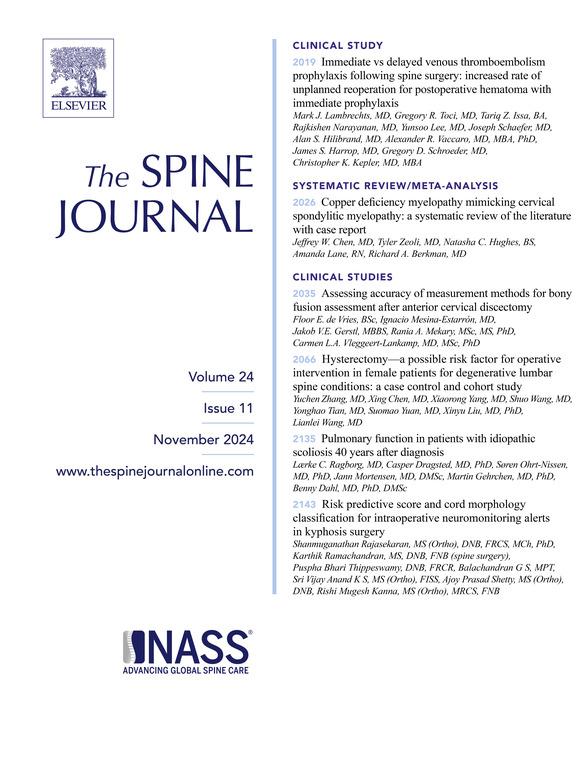84. Insertional torque and pull-out strength for reinserted porous threaded implants for sacroiliac joint fusion
IF 4.7
1区 医学
Q1 CLINICAL NEUROLOGY
引用次数: 0
Abstract
BACKGROUND CONTEXT
Sacroiliac joint (SIJ) fusion is a common procedure for SIJ dysfunction and pain. Historically, standard threaded screws were used; however, a novel 3D-printed porous threaded implant (PTI) has emerged to induce osseointegration. Limited literature exists on insertional and pullout characteristics, especially for revision.
PURPOSE
Therefore, this study investigated the re-insertional torque and pullout strength across various PTI dimensions and conditions.
STUDY DESIGN/SETTING
Biomechanical.
PATIENT SAMPLE
N/A
OUTCOME MEASURES
N/A
METHODS
Mechanical testing (ASTM F543) was conducted to evaluate insertional torque and pull-out strength. Using 10 and 20pcf (lbs/ft3) polyurethane blocks, the TORQ iFuse Implant (SI-Bone, Santa Clara, CA) was tested. A 10 × 35mm PTI served as the control. For subsequent tests, the 10 × 35mm PTI was removed, and varying diameters (10, 11.5, 12.5mm) and lengths (35, 40, 45mm) were reinserted. The maximum and final insertional torque and the maximum axial pullout load were measured. Reinsertion followed two conditions: direct and with tapping. ANOVA techniques with pairwise comparison and Pearson correlation tests between insertional torque and pullout force were performed (α=0.05).
RESULTS
Significant effects and interactions were observed for PTI size, bone density, and tapping. Independent of density and tapping, maximum insertional torque was significantly less than the control for the similar size PTI (10 × 35, 10 × 40; p< 0.001) and significantly greater for large PTIs (11.5 × 40, 11.5 × 45, 12.5 × 35, 12.5 × 40, 12.5 × 45; p< 0.012). Pullout force was significantly less than the control for short PTIs (10 × 35,11.5 × 35,12.5 × 35; p< 0.028) and significantly greater for long PTIs (11.5 × 45; p< 0.001). Independent of size and tapping, the denser bone was significantly greater for maximum insertional torque (20 vs 10pcf | 929.1±6.5N vs 235.0±6.5N·cm; p< 0.001) and pullout force (20 vs 10pcf | 1331.2±14.8 vs 457.3±14.6N; p< 0.001). Independent of size, tapping showed a significant increase for maximum insertional torque (‘tap’ vs ‘no tap’ | 1063.6±9.2 vs 794.5±9.2N-cm; p< 0.001) and pullout force (1799.1±20.9 vs 863.4±20.9N, p< 0.001) with the denser bone; however, a significant decrease was shown for pullout force (399.7±20.6 vs 514.9±20.6N; p< 0.001) with the less dense bone. Final insertional torque trends matched those for maximum insertion torque except for 20pcf foam without tapping, which was substantially less with increased diameters. Pullout force was shown to be correlated to maximum (r=.829; p<.001) and final (r=.946; p<.001) insertional torque across all conditions.
CONCLUSIONS
Increased PTI lengths equated to greater engagement, but exceedingly large diameters showed diminishing effects. Tapping was beneficial only for greater bone density. These findings underscore the importance of proper implant size and technique to ensure SIJ stability and prevent failure.
FDA Device/Drug Status
This abstract does not discuss or include any applicable devices or drugs.
84. 骶髂关节融合术中重新插入多孔螺纹植入物的插入扭矩和拔出强度
背景:骶髂关节(SIJ)融合术是治疗骶髂关节功能障碍和疼痛的常见手术。历史上,使用标准螺纹螺钉;然而,一种新型的3d打印多孔螺纹种植体(PTI)已经出现,以诱导骨整合。关于插入和拔出特征的文献有限,特别是关于修订的文献。因此,本研究考察了不同PTI尺寸和条件下的再插入扭矩和拔出强度。研究设计/ SETTINGBiomechanical。患者样本/结果测量/方法采用力学测试(ASTM F543)来评估插入扭矩和拔出强度。使用10和20pcf(磅/立方英尺)的聚氨酯块,测试了TORQ iFuse植入物(SI-Bone, Santa Clara, CA)。10 × 35mm PTI作为对照。在随后的测试中,取出10 × 35mm PTI,重新插入不同直径(10、11.5、12.5mm)和长度(35、40、45mm)的PTI。测量了最大、最终插入扭矩和最大轴向拉拔载荷。重新插入遵循两种情况:直接插入和轻叩。对插入扭矩和拔出力进行两两比较和Pearson相关检验的方差分析(α=0.05)。结果观察到PTI大小、骨密度和攻丝的显著影响和相互作用。独立的密度和攻丝,插入的最大扭矩明显低于类似规模的控制PTI(10 × 35岁10 ×40 ;术中,0.001)和显著更大的大型PTI(11.5 × 40岁11.5 × 45岁12.5 × 35岁12.5 × 40岁12.5 × 45;术中,0.012)。短pti组的拔拔力显著小于对照组(10 × 35,11.5 × 35,12.5 × 35;p< 0.028),而长pti组的拔拔力显著大于对照组(11.5 × 45;p< 0.001)。与尺寸和攻丝无关,骨密度越高,最大插入扭矩(20 vs 10pcf | 929.1±6.5N vs 235.0±6.5N·cm; p< 0.001)和拔出力(20 vs 10pcf | 1331.2±14.8 vs 457.3±14.6N; p< 0.001)显著越大。与尺寸无关,随着骨密度的增加,攻牙的最大插入扭矩(“攻牙”vs“无攻牙”)和拔牙力(1799.1±20.9 n vs 863.4±20.9 n, p< 0.001)显著增加;然而,在骨质密度较低的情况下,拔牙力明显降低(399.7±20.6 n vs 514.9±20.6 n; p< 0.001)。最终插入扭矩趋势与最大插入扭矩趋势相匹配,但不攻丝的20pcf泡沫随着直径的增加而明显减小。在所有条件下,拔出力与最大插入扭矩(r= 0.829; p< 0.001)和最终插入扭矩(r= 0.946; p< 0.001)相关。结论增加PTI长度等同于更大的接合,但过大的直径会减弱效果。敲击只对提高骨密度有益。这些发现强调了适当的种植体尺寸和技术对于确保SIJ稳定性和防止失败的重要性。FDA器械/药物状态本摘要不讨论或包括任何适用的器械或药物。
本文章由计算机程序翻译,如有差异,请以英文原文为准。
求助全文
约1分钟内获得全文
求助全文
来源期刊

Spine Journal
医学-临床神经学
CiteScore
8.20
自引率
6.70%
发文量
680
审稿时长
13.1 weeks
期刊介绍:
The Spine Journal, the official journal of the North American Spine Society, is an international and multidisciplinary journal that publishes original, peer-reviewed articles on research and treatment related to the spine and spine care, including basic science and clinical investigations. It is a condition of publication that manuscripts submitted to The Spine Journal have not been published, and will not be simultaneously submitted or published elsewhere. The Spine Journal also publishes major reviews of specific topics by acknowledged authorities, technical notes, teaching editorials, and other special features, Letters to the Editor-in-Chief are encouraged.
 求助内容:
求助内容: 应助结果提醒方式:
应助结果提醒方式:


